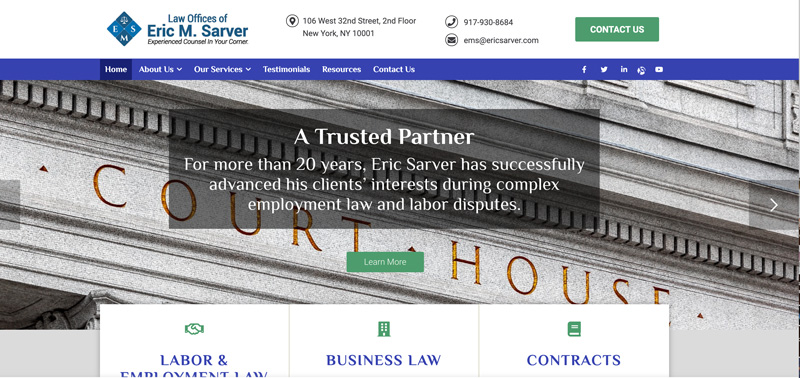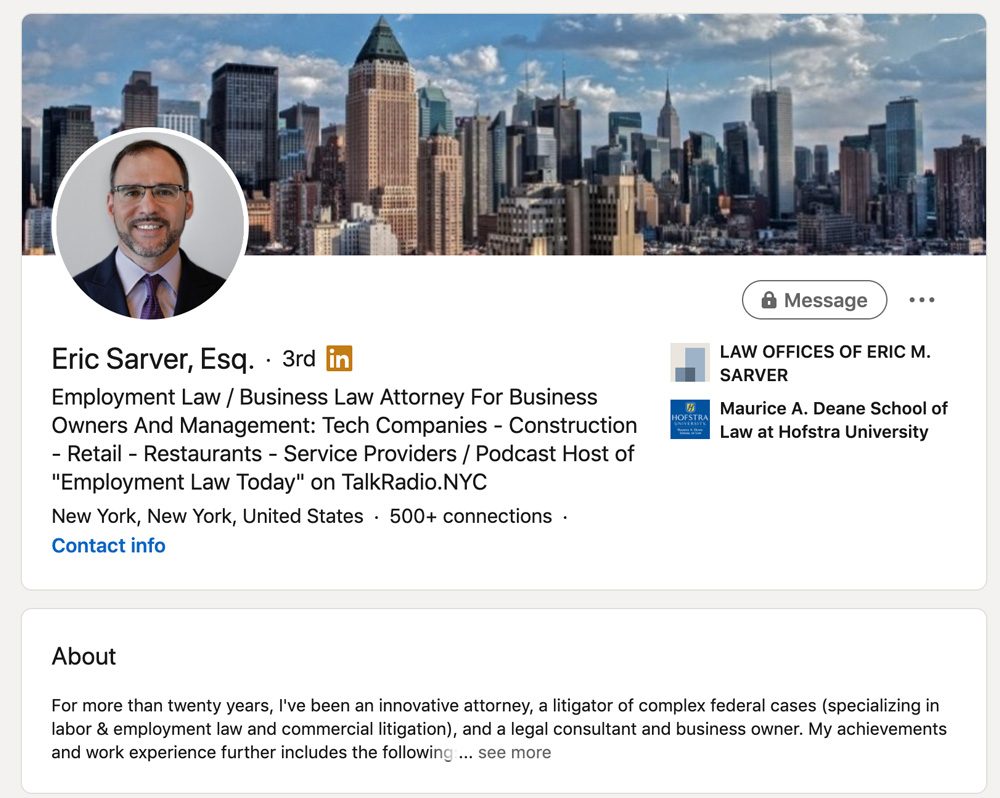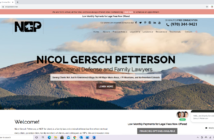Interactive virtual “town halls,” podcasting, LinkedIn, and Facebook are his main sources of new business.
Eric Sarver, a New York City employment law attorney, learned some lessons about marketing during the pandemic that will serve him well in post-pandemic times.
Networking and public speaking have been the main ways that Eric Sarver has marketed his solo New York City employment law practice since he launched The Law Office of Eric M. Sarver 20 years ago.
When all such in-person activities “came to a screeching halt” in March of 2020 during the coronavirus lockdown, Sarver found himself, like millions of others, rapidly moving his marketing efforts online on the fly.
He missed the “three-dimensional contact” with people. He did not miss commuting three hours roundtrip for two-hour meetings. Now that he can attend without leaving his desk, he is attending more events than he could have before. As have many others, Sarver has warmed up to online networking and figures it is here to stay, even as in-person gatherings resume.

Making Virtual Meetings Better
When the lockdown began, Sarver had several workshops on employment law topics already scheduled. He was able to hastily recast them as online webinars. He soon came to realize that a “virtual town hall” type format was more interesting and useful for participants.
“By the spring of 2020 I think everybody started to find their inbox filling up with messages from people saying ‘come to my webinar’,” says Sarver, who began to differentiate his virtual events by allowing more audience input. “Instead of just giving a presentation with a little bit of time at the end for Q&A, I try to make mine interactive,” he says. “Somebody speaks, pauses, and then we open up for questions, whether in the chat box or on Zoom.”
It takes some know-how to seamlessly manage a multi-party video chat, but “that shouldn’t scare anyone away from having a virtual panel discussion with other people,” Sarver says. “What you need to figure out beforehand is how to share the screen, how to co-host, and how to mute or unmute. All of that can be handled in one or two tutorials, or by trial and error.”
Sarver learned by trial and error that it also pays to put some thought into sound and lighting. He learned to avoid backlighting, which produces a silhouette effect, and bright lights from directly overhead, which can make your skin look like it is changing colors. He also learned to avoid looming in too close to the camera.
Sarver purchased a good microphone after figuring out that the one he was using was picking up ambient noise. “I also now have a certain place set up with bookshelves and personal pictures in the background,” which “gives people a better sense of who I am,” he says.
Sarver has sometimes used virtual backgrounds, though he is aware they get mixed reviews. “Some people say they look fake, or make it look like you are hiding a messy bedroom. But I disagree. I think if you get a classy, virtual background that is serious and professional, people tend to understand that it’s an office setting that you are trying to recreate.”
Whatever the case, aesthetics matter. “If you have a great message, it can get lost if you have bad lighting or if the audience is distracted because you don’t have a good microphone. It’s important to pay attention to all those things, just like you wouldn’t show up in court with a great argument but poorly dressed.”

Talk Radio and Podcasting Extended His Reach
Sarver’s most recent foray into networking from a distance is a show he conceptualized, created, and began hosting on Talk Radio.NYC, called “Employment Law Today.” For his shows, as he has done with the workshops he has set up over the years, Sarver often teams up with professionals in a complementary field. “I pick a topic that I want to discuss and I try to figure out which person I know would be best to talk about that, and then I come up with some questions and I email it to the person in advance. And then, of course, I invite them to talk about themselves and their company.”
The shows are “a mix of scripted and organic,” he says. “Usually what I try to do is set the tone and then of course as we’re talking, issues come up.”
Using the Talk Radio.NYC platform is worth the cost, Sarver says. “Anyone can start a podcast on their own, but when you are part of a group, you have the backing of the name and I think that lends your show more credibility.”
Multi-Platform Marketing
The shows are especially useful for marketing purposes because the episodes remain online indefinitely. “No longer is the audience only those who show up that day,” Sarver says. “It is not so crucial anymore to get a critical mass of people to tune in at 5 o’clock on Tuesday evening.” It remains accessible long after to a broader audience.
Best of all, he can get multiple uses out of the content. “What I am finding now is that with everything on Zoom or on Talk Radio NYC, I can upload a show to my website or to social media platforms, or I can take clips from shows and post them on LinkedIn, Facebook or Twitter,” Sarver says. He can also send links to particular episodes to prospective clients who may have contacted him about the issue under discussion. “It not only gives the client some helpful background information on their matter, it also sets me apart as an authority,” Sarver says.

Uses of Social Media
Sarver has found some social media platforms more useful than others. “The most important for me, hands down, have been LinkedIn and Facebook,” says Sarver. LinkedIn is a smaller pond than the “vast universe” of Twitter, “but it is also dedicated to professionals and business owners, so I have found it to be extraordinarily helpful.”
He posts original articles and blog posts on LinkedIn, though it is easy to maintain an active presence without original input, he says. “I can repost articles by other people, giving credit where due, and add a couple of sentences to describe the article in my post ,” he says. “For instance, I posted about an article I found about liability for employers during the pandemic and another on overtime laws.”
“On Facebook I can post from ‘The Law Office of Eric M. Sarver’ page, or as an individual. There are also groups on Facebook and groups on LinkedIn that I am a part of,” says Sarver, who is active in the New York Small Business Owners groups and the New York City Hospitality groups on both LinkedIn and Facebook. He posts content geared not only toward his clients but also toward other professionals who could potentially refer cases to him. “I will sometimes post in, for example, online accountants’ groups or groups for a particular field of professionals,” he says.
“I find that whether on LinkedIn or in a blog post on Facebook or other social media platforms, people want to receive information in succinct terms. I will add in legal facts and caselaw so that people will know that my article is based in law, but in each piece I try to focus on a theme that is short and sweet,” Sarver says.
He updates and recycles pieces on recurring themes, such as “Five Employment Law Issues That Business Owners Should Be Concerned About,” and “Spring Cleaning: Five Essential Items That Every Business Should Review.” Sarver also keeps a lookout for new publications or platforms that might publish his pieces, or reporters covering employment law topics who might use him as a source. “I do seek out reporters sometimes, and other times they seek me out because I am active on social media and on LinkedIn,” says Sarver.
Talking to the press can also help, no matter how far afield. “I might talk to a reporter in Louisiana writing for a certain trade publication in the South. While I don’t have clients in Louisiana, I can take that link and send it to my colleagues in New York.”
Having a Strong Website Presence
Having a good website is “critical” for a solo practitioner’s success, in Sarver’s view. “That is your virtual office and you don’t want it to look like a hole in the wall. You will want it to look like a professional, modern, clean ‘office.’ I recommend using a website designer that knows about modern web design,” says Sarver, who started out using a friend to build his website and later hired a professional web designer to enhance what the friend had created.
“I started to realize that potential clients might get my name and hear high praise about me from a former client, or someone else they trusted. But those potential clients would want to know who I am before they call me, and the easiest way to do that is to look at my website. So I upgraded my website, and I am glad I did,” he says.
“You might know which clients you gain from having a good website,” says Sarver. But if someone is underwhelmed by a shabby website, or for that matter a shaky online presentation, and never calls, you’ll never hear about it. “You never know which potential clients you lose because of the little things,” Sarver says.




